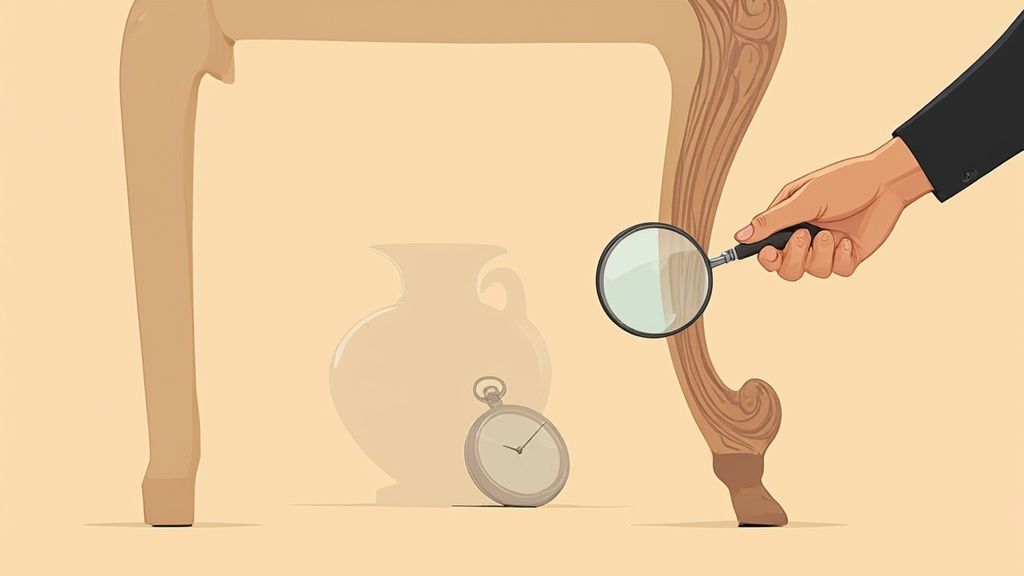Learning how to identify antiques really comes down to a few key principles. Officially, a genuine antique is something that's at least 100 years old, but the real story is told through its materials, construction, and the unique signs of its life.
Your First Steps in Antique Identification
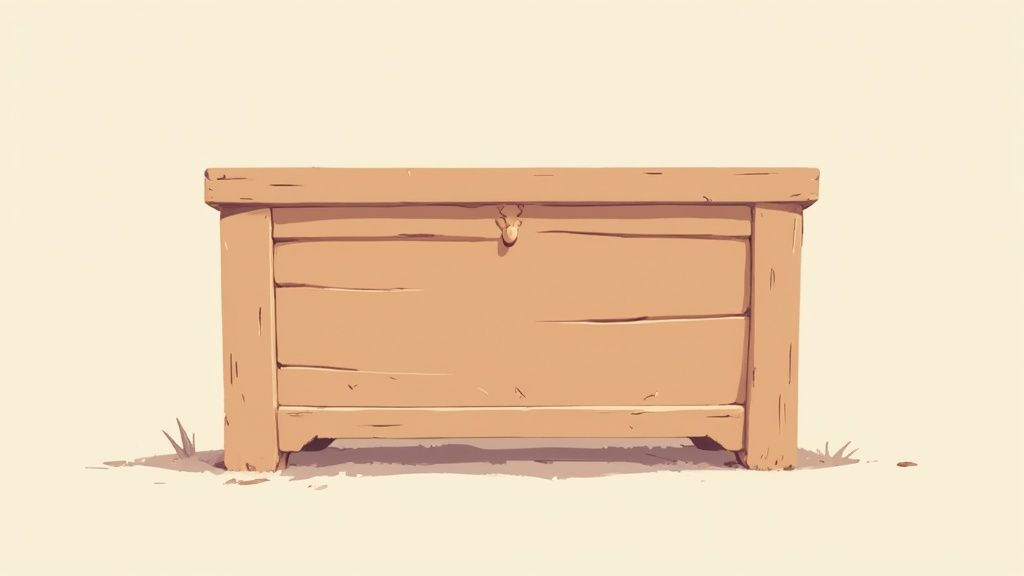
Before you can spot a hidden gem in the dusty corner of a thrift shop, you need to understand what separates an old item from a true antique. While the "100-year rule" is a handy guideline, it’s just the starting point. The real art is learning to see the subtle clues that distinguish a period piece from a clever reproduction.
This first look is all about training your eye and building a mental checklist. Every time you pick up a potential find, you should start asking questions. Does it have the right heft? Do you see signs of hand-craftsmanship, or the tell-tale uniformity of machine production? Getting these initial observations down is the foundation of the whole process.
The Mental Checklist Every Beginner Needs
Think of this as your internal monologue whenever you encounter an interesting object. It’s not about having all the answers right away, but about knowing what to look for. This simple framework will guide your investigation and stop you from overlooking critical details.
- Age and the 100-Year Rule: Does the item feel old enough? This is your first gut check.
- Material Integrity: What’s it made of? Old-growth wood, early plastics, and hand-blown glass all have a look and feel of their own.
- Construction Clues: Look for hand-cut dovetails, irregular nails, or signs of modern fasteners like staples or Phillips head screws.
- Style and Form: Can you place the design? Does it scream Art Deco, or have the ornate feel of the Victorian era?
Developing this instinct is a huge part of antique collecting for beginners. Every object you examine builds your visual and tactile library, making the next identification that much easier.
A genuine antique tells a consistent story. The style, materials, and wear should all point to the same time period. If a chair has a classic Queen Anne shape but is held together with modern screws, something isn't right.
Why Identification Matters in Today's Market
Having a sharp eye isn't just for personal satisfaction; it's a crucial skill in a very active market. In 2024, the global antique market generated $58.4 billion in revenue, which shows just how much interest there is in these historical treasures.
Online platforms have made antiques more accessible than ever, but they've also made it more important for buyers to be knowledgeable. You’re often buying from photos alone, so you have to know what you’re looking at.
To get started, it helps to have a quick reference for the initial signs you should be looking for.
Quick Clues for Antique Identification
This table summarizes the initial, observable characteristics that can help you begin the identification process. Think of it as your first-glance guide.
| Characteristic | What to Look For | Why It Matters |
|---|---|---|
| Wear & Tear | Uneven wear in logical places (e.g., drawer pulls, chair arms). | Consistent, natural wear suggests authentic use over time. Fakes often have artificially distressed or uniform wear. |
| Symmetry | Slight imperfections, lack of perfect symmetry. | Before mass production, items were handmade and rarely perfectly symmetrical. Perfect uniformity can be a red flag. |
| Fasteners | Slot-head screws, handmade nails, dovetail joints. | Modern Phillips head screws weren't common until the 1930s. The type of joinery and hardware is a huge clue to age. |
| Materials | Patina on metals, shrinkage or saw marks on wood. | Materials age in predictable ways. A deep, rich patina on bronze or the slight warping of old wood is hard to fake. |
Using these clues as a starting point will put you on the right track. As you gain experience, spotting these details will become second nature, helping you evaluate potential finds with much more confidence.
Decoding an Antique's Maker's Marks
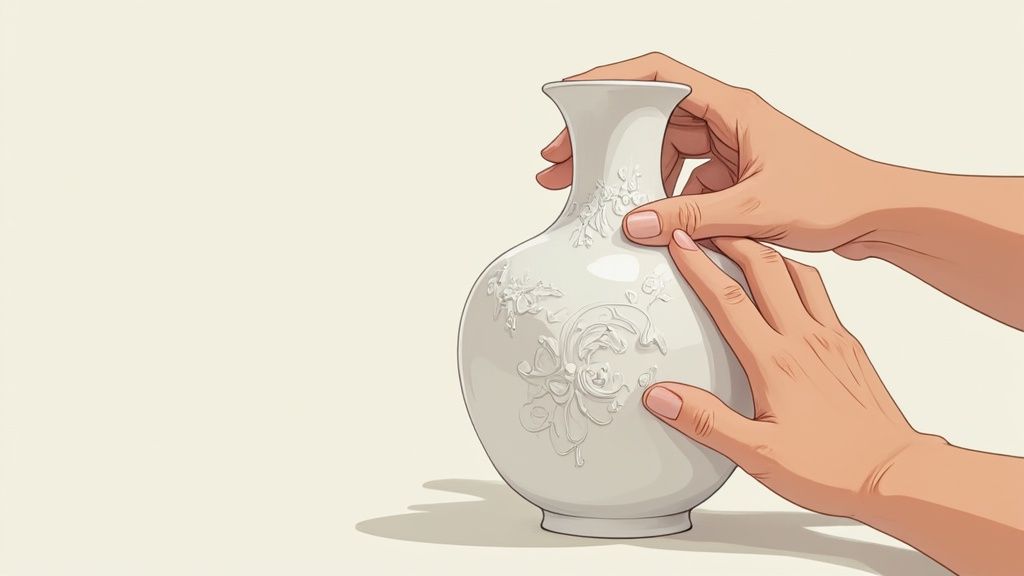
One of the most reliable ways to get to the bottom of an antique's story is to find and understand its maker's mark. These little signatures—whether they're stamped, painted on, or pressed into the material—are your direct line to the object's creator, where it came from, and often, a very specific timeframe.
Think of it as the start of a conversation with the past.
Finding these marks is often the first challenge. They're usually tucked away in discreet spots to avoid messing with the item's aesthetic. For a piece of furniture, you’ll want to check the back, inside the drawers, or on the underside. With ceramics and glassware, the base is your best bet. On silver, carefully inspect the handle or the main body of the piece.
Reading Different Types of Marks
Once you find a mark, you'll realize they aren't all the same. You'll run into a few common types, and learning to tell them apart is crucial for getting an accurate ID. A simple mark might just be a company logo, but there's often more to the story.
- Company Logos: This is the most straightforward mark, identifying the manufacturer. Keep in mind that brands like Wedgwood or Royal Doulton changed their marks over the years, so the specific logo you find can help you date a piece to within a pretty narrow window.
- Artist Signatures: On hand-painted porcelain or higher-end decorative art, you might be lucky enough to find the initials or full signature of the artist who decorated it. This can make a piece much rarer and more valuable.
- Patent or Registration Numbers: These numbers tell you the design itself was protected. For instance, British pieces made between 1842 and 1883 often have a "kite mark" that actually encodes the exact day the design was registered.
Learning to distinguish these is a skill you'll develop over time. For example, the detailed process to identify antique jewelry often involves deciphering a complex series of tiny hallmarks for metal purity right alongside the maker's stamp.
Don't assume that any mark automatically means an item is an antique. Plenty of modern companies use marks. The real work is in researching the specific mark to confirm the company and the era when that particular logo was used.
Where to Research Your Findings
Once you've found and photographed the mark, the real detective work can start. The goal is to match your mark to a known example in a reference guide. Thankfully, we have some fantastic resources at our fingertips today.
Online databases are a game-changer. Websites like Kovels or Antique-Marks.com have massive visual libraries of marks from all over the world, which you can search by shape, country, or material. For ceramics, Replacements.com is another incredible resource, especially for identifying patterns once you've pinned down the maker.
But don't discount physical reference books, especially for more specialized categories. I can't tell you how many times a dedicated book on French porcelain or American silverware has saved the day. These guides contain a depth of information that broader websites sometimes miss. By comparing your find to these trusted sources, you can turn a mysterious symbol into a concrete piece of history and confidently unlock your antique's story.
Reading the Clues in Materials and Construction
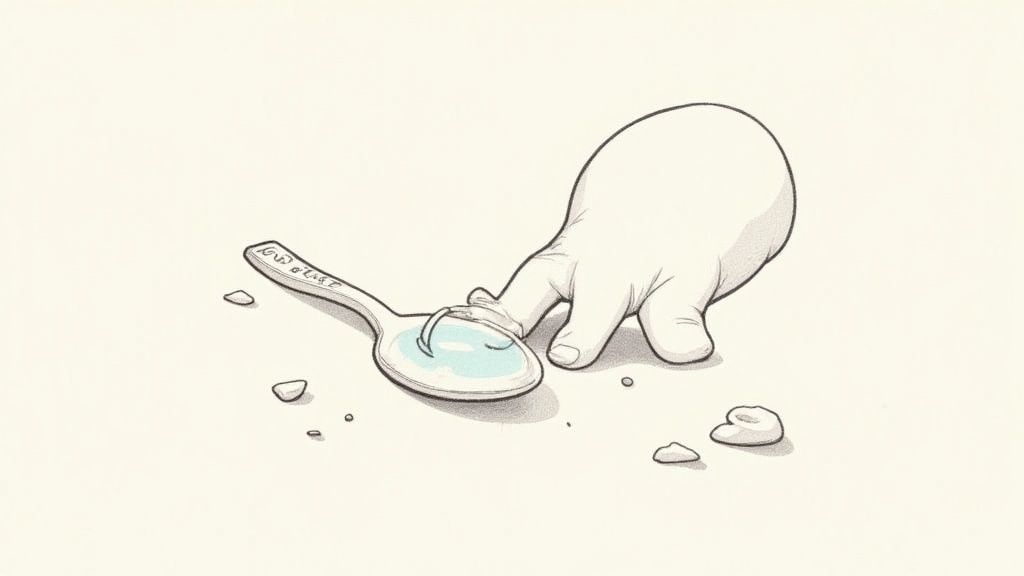
While a maker's mark is a fantastic find, some of the most dependable clues are hiding in plain sight. They’re baked right into the materials and the way a piece was put together. The construction of an object is like a tangible record of its era, a story you can read with your hands.
This is where you move beyond books and learn to trust your senses. You're trying to feel the distinct weight of old-growth wood, spot the subtle imperfections left by hand tools, and recognize the honest wear that only time can create. A true antique simply feels different from a modern reproduction because it was made with different materials, tools, and a completely different mindset.
Learning to Feel the Difference
Let's talk about the joints in a piece of wooden furniture. Before machines took over in the mid-19th century, the dovetail joints holding drawers together were meticulously cut by hand. This human touch always left behind slight irregularities.
- Hand-Cut Dovetails: Look for uneven spacing. The pins and tails won't be perfectly uniform. Often, the pins are thinner and more delicate than the tails.
- Machine-Cut Dovetails: These are the dead giveaway of factory production, common after the 1860s. They are perfectly spaced, sharp, and identical.
Just by pulling out a drawer and running your fingers along the joints, you can uncover a huge part of its story. This same logic applies to other hardware. Square-headed nails are a good sign of a pre-1800 origin, while round-headed nails point to the 19th century. If you see a Phillips head screw, you know for sure that the piece—or at least a repair—dates to the 1930s or later.
A common mistake is to dismiss an item because of a single modern screw. It might simply indicate a later repair. The key is to look for a convergence of evidence. If the wood, style, and other construction methods all point to an earlier date, a lone screw might just be part of its life story.
Examining Glass and Wood Imperfections
Early glass offers another fantastic set of clues. Before modern manufacturing, glass was never perfectly clear or smooth. When you're looking at old glassware, bottles, or mirrors, keep an eye out for these tell-tale signs:
- Bubbles and Seeds: Small air bubbles trapped inside the glass are a hallmark of pieces made before the 20th century.
- Waviness: Hold the glass up to a light source. Older panes often have a slightly wavy or distorted look to them.
- Pontil Mark: Hand-blown glass was attached to a pontil rod. When snapped off, it leaves a rough, circular mark on the base. A pontil mark that has been ground down and smoothed often indicates a higher-quality piece from the 18th or 19th century.
The wood itself has stories to tell, too. Look for the straight, dense grain of old-growth timber—something you just don't see in most modern furniture. Also, check for saw marks. The faint, arcing marks of a circular saw suggest a post-1850 date, whereas straight, rougher saw marks point to an earlier piece cut by hand.
This kind of hands-on evaluation is absolutely essential. The market is full of convincing reproductions, and as historical sales data consistently shows, proper authentication is what separates a decorative item from a valuable antique. For a deeper dive into market trends, the 2025 Antiques, Items Over 100 Years Old Retail Sales report provides excellent insights that help experts validate the age and authenticity of a piece.
Get Fluent in the Language of Design Styles
Every antique speaks a language. Its shape, its carvings, and its overall aesthetic tell a story about the time and place it was made. Learning to read these visual cues is one of the most powerful skills you can develop. It moves you past broad labels like "Victorian" and into the nitty-gritty details that separate the authentic from the imitation.
Think of it as your ultimate cross-check. If the maker's mark and construction point to the 1890s, the style had better match. I’ve seen countless pieces with convincing-looking wear, only to realize the design language was all wrong for the supposed era. That visual vocabulary has saved me from some very expensive mistakes over the years.
Getting a Feel for the Major Eras
Your first goal is to get familiar with the major design movements. Don't worry about memorizing exact dates just yet. Instead, focus on the why. What was each style reacting to? History is a pendulum, and design often swings in direct opposition to what came before.
A perfect example is the Arts and Crafts movement (c. 1880–1920). It was a full-blown rebellion against the fussy, machine-made excess of the Victorian era.
- Arts and Crafts: This style celebrates honesty. You’ll see simple, strong lines, visible joinery like mortise and tenons, and a deep appreciation for the craftsman's hand. Oak was the hero wood, and the whole vibe feels solid and functional.
- Victorian (Rococo Revival): In contrast, this style is all about opulence. It’s defined by extravagant carvings, sensuous S-curves, and a heavy, ornate presence. Picture dark woods like mahogany and walnut, covered in carved fruits, flowers, and vines.
Seeing them side-by-side, the difference is stark. One champions clean, handcrafted utility; the other shouts wealth and status. Recognizing these core philosophies is your first big step.
My biggest piece of advice: Remember that styles don’t just stop and start on a dime. You’ll always find transitional pieces where elements from one era bleed into the next. Spotting that overlap is a pro-level move that can help you pinpoint an object's age with incredible accuracy.
Zeroing In on Motifs and Details
Once you can tell the big movements apart, it’s time to zoom in on the "words"—the specific motifs that define a period’s design language. These are the small details that act as undeniable fingerprints.
Take the Neoclassical style of the late 18th and early 19th centuries. Designers were obsessed with the discoveries at Pompeii and Herculaneum, so they borrowed heavily from ancient Greek and Roman design.
Key Neoclassical Motifs to Look For:
- Classical urns and draped swags
- Straight, column-like legs (often fluted or reeded)
- Delicate inlaid medallions
- A love for symmetry and geometric patterns
Now, jump forward about 100 years to the Art Nouveau period (c. 1890–1910). This movement also looked to nature, but through a completely different lens. It’s all about sensuous, flowing, and asymmetrical lines—often called "whiplash" curves. Spotting a stylized iris on a vase or the delicate wings of a dragonfly on a lamp is an instant tell.
Building this mental library of motifs allows you to walk up to an object and confidently say, "Yes, this design truly belongs to its time."
Evaluating Condition, Wear, and Provenance
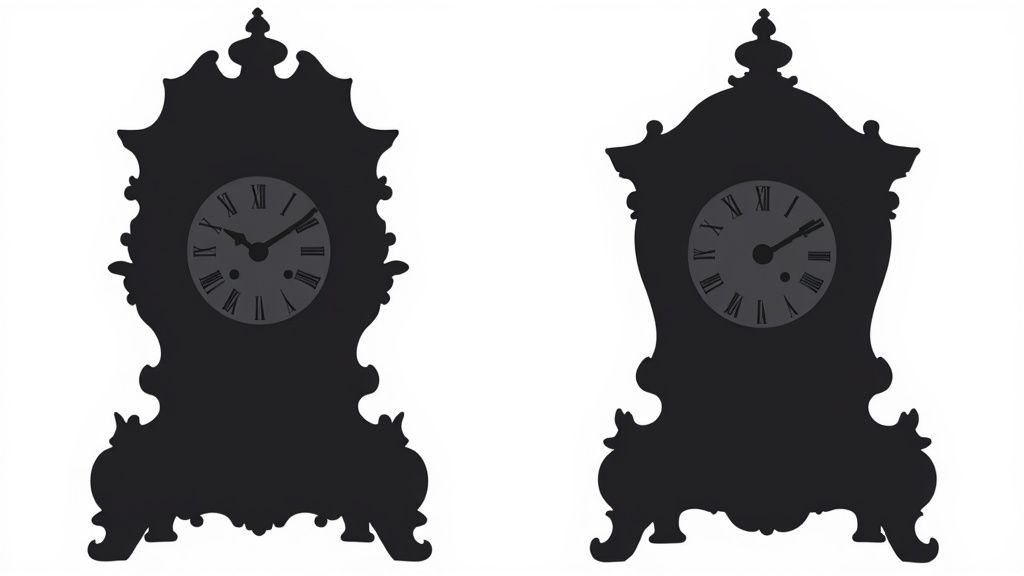
After you've got a feel for an item’s style and how it was made, the next step is to dig into its personal history. This means looking closely at its condition and, if you're lucky, uncovering its provenance. These two factors are what separate a truly valuable antique from just another old object. Learning to read the story told by an item's wear and tear is one of the most important skills you can develop.
It all starts with distinguishing honest wear from outright damage. A genuine patina, for instance, is a good thing. It’s that soft, warm glow on a wooden tabletop that's seen a hundred years of polishing, or the subtle darkening on a brass drawer pull. This kind of wear is earned. It shows up exactly where you'd expect it from decades of use.
Damage, on the other hand, is a different story. We're talking about things like deep water rings, major cracks, or chunks of wood missing. This isn't character; it's a flaw that usually hurts the value.
What Does "Good Condition" Really Mean?
Here's something you learn quickly: "good condition" is completely relative. What's considered acceptable for a 200-year-old piece would be a deal-breaker for something from the 1950s.
For example, a tiny, almost invisible hairline crack on an 18th-century porcelain teacup might be perfectly fine. It's survived for centuries, after all. But that same kind of crack on a piece of mid-century modern furniture? That’s a serious issue. You always have to judge condition based on the item's age and what it's made of.
Repairs are another area to watch.
- Historic Repairs: I’ve seen old, masterful repairs that actually add to a piece's charm. A beautifully done riveted repair on a ceramic platter tells you it was so loved that someone went to great lengths to save it.
- Modern Repairs: A sloppy, modern fix with the wrong glue or materials is a huge red flag. It often screams that the damage was severe and the "repair" was done cheaply, which can tank the value.
The key takeaway here is that you're not hunting for perfection—flawless antiques are incredibly rare. You're looking for honesty. Does the wear on the piece make sense for its age and purpose? That’s the question that helps you separate the real deal from the fakes.
The Power of Provenance
Beyond the physical object itself, an antique's provenance—its documented history of ownership—can be its most valuable feature. This is the paper trail, the evidence that proves where an item has been and who has owned it.
Provenance isn't just one thing; it can come in many forms:
- An original bill of sale from when it was first purchased.
- Old family photos where the piece is visible in the background.
- Letters or diary entries that mention the item.
- A formal appraisal certificate from decades ago.
A solid provenance turns an interesting old "thing" into a verifiable piece of history. It eliminates doubt about its age and authenticity and can make it far more desirable on the market. This is a massive factor when you start to learn how to value antiques, as a documented story can easily double or even triple an item's price.
This desire for items with a story is a huge driver in the collectibles world. The global second-hand collectibles market was valued at a staggering $142.5 billion in 2024 and is expected to keep growing. People want unique pieces with a past. Understanding both an object's physical state and its life story is how you go from being someone who just finds old things to someone who truly understands them.
Common Questions on Identifying Antiques
As you get your hands dirty in the world of antiques, you’ll find that certain questions come up time and time again. These are the practical, in-the-moment concerns I hear from almost every new collector I meet. Think of this as your field guide for those moments of doubt, designed to build your confidence and reinforce what you've learned.
What Is the Single Most Important Clue?
Everyone wants that one magic bullet, that single sign that screams "authentic." But in my experience, the real secret is the convergence of evidence. A genuine antique tells a consistent story, no matter how you look at it.
For example, a true Queen Anne style chair from the mid-18th century ought to be made from walnut or maybe mahogany. You'd expect to see the faint, irregular marks of hand tools, not the perfect lines of a modern saw. If the style says 1740 but the screws are from a hardware store in 1950, you’ve found a major red flag. True identification is a puzzle where all the pieces—style, material, construction, and wear—fit together perfectly.
How Can I Spot Fake Aging Versus Natural Wear?
This is a big one. Natural aging, what we call patina, is a logical process. It shows up where an object was touched, used, and exposed to life over many decades. Think of the worn arms of a favorite chair, the smooth, darkened edge of a drawer pull, or the slightly softened rim of a porcelain bowl. It tells a story.
Faked aging, on the other hand, often feels random and illogical. You might find "distressing" in protected crevices where hands would never reach or see suspiciously uniform dents from someone taking a chain to a piece of furniture.
I always tell people that natural wear is earned, while fake wear looks applied. One feels organic and consistent with how the object was meant to be used; the other just feels forced.
Does Being Old Automatically Make It Valuable?
This is probably the biggest myth out there, and the answer is a firm no. Age is just one ingredient in the recipe for value. An object can be a certified antique, over 100 years old, and still be worth very little. This happens all the time with items that were mass-produced, are in rough shape, or simply aren't in demand among today's buyers.
True value emerges at the intersection of several key factors:
- Rarity: How many of these are still out there?
- Condition: How well has it survived its long life?
- Demand: Are people actively looking for this style or maker right now?
- Beauty: Does it have that "it" factor—a timeless aesthetic appeal?
A rare, beautifully preserved piece will almost always be more valuable than a common, damaged item of the same vintage.
When Is It Time to Call a Professional Appraiser?
The skills you're learning here are fantastic for flea market hunting, personal collecting, and initial vetting. But there are specific times when you absolutely need to bring in a professional. If you need a formal valuation for insurance purposes, estate planning, or are considering a major sale, it's time to call an appraiser. This is non-negotiable for a potentially high-value find.
A certified appraiser offers specialized expertise and access to auction records and sales databases that go far beyond what you can find with a simple Google search. They provide a formal, unbiased report on an item's authenticity and fair market value—an essential document for any significant financial decision.
Ready to turn your curiosities into discoveries? With Curio, you can instantly identify antiques, heirlooms, and thrift store finds with just a photo. Get the history, origin, and value of any object in seconds. Download the app and start uncovering the stories behind your treasures today at https://www.curio.app.
